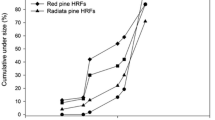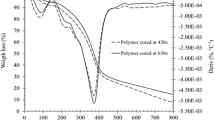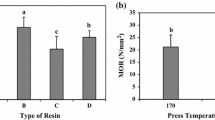Abstract
Recycling of the urea–formaldehyde (UF) products mainly obtained from adhesive wastes of wood industries is vital and requires a high level of attention due to the environmental and human health impacts of formaldehyde and other chemicals. In this study, the complete polymerized resin, as undesired waste product of Chassbsaz company, has been recycled and reused in the manufacturing process of medium density fiberboards (MDF). The results demonstrated that by adding recycled polymerized powder in sub-micron size to urea–formaldehyde control resin and replacing 1 wt% of the 55% solid content resin, the curing time of the resin significantly decreased. Fourier transform infrared spectroscopy (FTIR) demonstrated the chemical stability of the UF resins after adding 1 wt% recycled polymerized resin. In addition, there were substantial improvements in physical–mechanical properties [i.e., modulus of elasticity (MOE), modulus of rupture (MOR), internal bond (IB) strength and thickness swelling (TS)] of the newly manufactured board compared to that of the control board. Analysis of variance (ANOVA) was employed to study the dependency and significance of the physical–mechanical properties of the MDF on the concentration of the recycled polymer. Moreover, the production capacity was expected to significantly increase as the curing time decreased while maintaining the outstanding mechanical characteristics of the boards.






Similar content being viewed by others
References
Ashori A, Nourbakhsh A (2009) Effects of nanoclay as a reinforcement filler on the physical and mechanical properties of wood-based composite. J Compos Mater 43(18):1869–1875
ASTM D1081-60 (1968) Standard method of test for evaluating pressure sealing properties of rubber and rubber-like materials. Am Soc Test Mater:1–3
Ayrilmis N (2012) Enhancement of dimensional stability and mechanical properties of light MDF by adding melamine resin impregnated paper waste. Int J Adhes Adhes 33:45–49
Bezerra MA, Santelli RE, Oliveira EP, Villar LS, Escaleira LA (2008) Response surface methodology (RSM) as a tool for optimization in analytical chemistry. Talanta 76(5):965–977
Boran S, Usta M, Gümüşkaya E (2011) Decreasing formaldehyde emission from medium density fiberboard panels produced by adding different amine compounds to urea formaldehyde resin. Int J Adhes Adhes 31(7):674–678
Conner AH (1996) Urea–formaldehyde adhesive resins. Polym Mater Encycl 11:8496–8501
Costa N, Pereira J, Martins J, Ferra J, Cruz P, Magalhães F, Mendes A, Carvalho L (2012) Alternative to latent catalysts for curing UF resins used in the production of low formaldehyde emission wood-based panels. Int J Adhes Adhes 33:56–60
Cyr P-L, Riedl B, Wang X-M (2008) Investigation of urea-melamine-formaldehyde (UMF) resin penetration in medium-density fiberboard (MDF) by high resolution confocal laser scanning microscopy. Eur J Wood Prod 66(2):129–134
Derkyi N, Darkwa N, Yartey J (2008) Effect of cassava flour as urea formaldehyde adhesive extender on the bonding strength of plywood. Ghana J For 23(24):25–34
Dunky M (1998) Urea–formaldehyde (UF) adhesive resins for wood. Int J Adhes Adhes 18(2):95–107
Dupre FC, Foucht ME, Freese WP, Gabrielson KD, Gapud BD, Ingram WH, McVay TM, Rediger RA, Shoemake KA, Tutin KK (2000) Cyclic urea–formaldehyde prepolymer for use in phenol–formaldehyde and melamine–formaldehyde resin-based binders. US Patent 6,114,491
EN 310 (1993) Wood-based panels: determination of modulus of elasticity in bending and of bending strength. CEN European Committee for Standardization, European Union
EN 316 (1999) Wood fibreboards. Definition, classification and symbols. CEN European Committee for Standardization, European Union
EN 317 (1993) Particleboards and fibreboards: determination of swelling in thickness after immersion in water. CEN European Committee for Standardization, European Union
EN 319 (1993) Particleboards and fiberboards, determination of tensile strength perpendicular to plane of the board. CEN European Committee for Standardization, European Union
EN 326 (1994) Wood-based panels, sampling and cutting of test pieces and inspection. CEN European Committee for Standardization, European Union
Finch C (1984) Wood adhesives: chemistry and technology. Pizzi A (ed) Marcel Dekkar, New York, 1983. Pp ix + 364, price SFr 174.00. ISBN 0814715799. Wiley Online Library
Gadhave RV, Mahanwar PA, Gadekar PT (2017) Factor affecting gel time/process-ability of urea formaldehyde resin based wood adhesives. Open J Polym Chem 7(02):33
Gan SN, Tan BY (2001) FTIR studies of the curing reactions of palm oil alkyd–melamine enamels. J Appl Polym Sci 80(12):2309–2315
Gao W, Du G, Ma H, Li J (2016) Dynamic mechanical analysis of urea formaldehyde resin modified by ammonium pentaborate as wood adhesive. Polym Comp 37(8):2404–2410
Ghafari R, DoostHosseini K, Abdulkhani A, Mirshokraie SA (2016) Replacing formaldehyde by furfural in urea formaldehyde resin: effect on formaldehyde emission and physical–mechanical properties of particleboards. Eur J Wood Prod 74(4):609–616
Halvarsson S, Edlund H, Norgren M (2008) Properties of medium-density fibreboard (MDF) based on wheat straw and melamine modified urea formaldehyde (UMF) resin. Ind Crops Prod 28(1):37–46
Jada SS (1988) The structure of urea–formaldehyde resins. J Appl Polym Sci 35(6):1573–1592
Jang Y, Huang J, Li K (2011) A new formaldehyde-free wood adhesive from renewable materials. Int J Adhes Adhes 31(7):754–759
Kaboorani A, Riedl B (2011) Effects of adding nano-clay on performance of polyvinyl acetate (PVA) as a wood adhesive. Compos Part A Appl Sci Manuf 42:1031–1039
Kaboorani A, Riedl B, Blanchet P (2013) Ultrasonication technique: a method for dispersing nanoclay in wood adhesives. J Nanomater 3:1–9
Kumar A, Gupta A, Sharma K, Nasir M, Khan TA (2013) Influence of activated charcoal as filler on the properties of wood composites. Int J Adhes Adhes 46:34–39
Lee Y-K, Kim H-J (2013) Relationship between curing activation energy and free formaldehyde content in urea–formaldehyde resins. J Adhes Sci Technol 27(5–6):598–609
Lei H, Du G, Pizzi A, Celzard A (2008) Influence of nano-clay on urea formaldehyde resins for wood adhesives and its model. J Appl Polym Sci 109(4):2442–2451
Maloney TM (1977) Modern particleboard and dry-process fiberboard manufacturing. Miller Freeman Publications, San Francisco
Motter WK, Daisy NK, Detlefsen WD (1997) Catalytic composition and method for curing urea–formaldehyde resin. US Patent 5:635,583
Moubarik A, Mansouri HR, Pizzi A (2013) Improving UF particleboard adhesives water resistance by small albumin and sunflower oil additions. Eur J Wood Prod 71(2):277–279
Myers GE (1984) How mole ratio of UF resin affects formaldehyde emission and other properties: a literature critique. For Prod J 34(5):35–41
Nuryawan A, Park B-D, Singh AP (2014) Comparison of thermal curing behavior of liquid and solid urea–formaldehyde resins with different formaldehyde/urea mole ratios. J Therm Anal Calorim 118(1):397–404
Osemeahon S, Barminas J (2007) Study of some physical properties of urea formaldehyde and urea proparaldehyde copolymer composite for emulsion paint formulation. Int J Phys Sci 2:169–177
Park B-D, Jeong H-W (2011) Hydrolytic stability and crystallinity of cured urea–formaldehyde resin adhesives with different formaldehyde/urea mole ratios. Int J Adhes Adhes 31(6):524–529
Pizzi A (1994) Advanced wood adhesives technology. CRC Press, Boca Raton
Roffael E (2012) Influence of resin content and pulping temperature on the formaldehyde release from medium density fibreboards (MDF). Eur J Wood Prod 70(5):651–654
Xian D (2012) Effect of nanoclay filler on wood adhesives and particle board properties. Thesis, University of British Columbia, Vancouver
Zhong R, Gu J, Gao Z, Tu D, Hu C (2017) Impacts of urea–formaldehyde resin residue on recycling and reconstitution of wood-based panels. Int J Adhes Adhes 78:60–66
Acknowledgements
This work was financially supported by Arian Saeed Industrial Group and the authors are thankful to Mr. Ali Saeedi, the head of this industrial group for his invaluable support. Further, special gratitude to all employees in Chassbsaz and Arian Sina companies for their support in this research.
Author information
Authors and Affiliations
Corresponding author
Additional information
Publisher’s Note
Springer Nature remains neutral with regard to jurisdictional claims in published maps and institutional affiliations.
Rights and permissions
About this article
Cite this article
Khonakdar Dazmiri, M., Valizadeh Kiamahalleh, M., Valizadeh Kiamahalleh, M. et al. Revealing the impacts of recycled urea–formaldehyde wastes on the physical–mechanical properties of MDF. Eur. J. Wood Prod. 77, 293–299 (2019). https://doi.org/10.1007/s00107-018-1375-z
Received:
Published:
Issue Date:
DOI: https://doi.org/10.1007/s00107-018-1375-z




